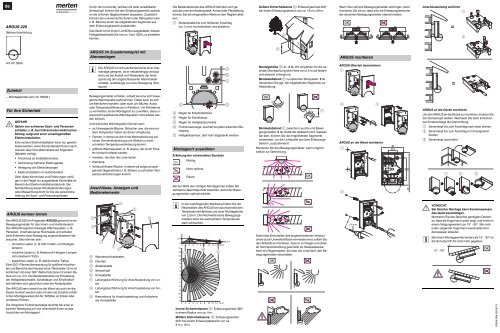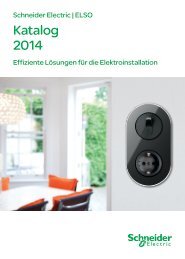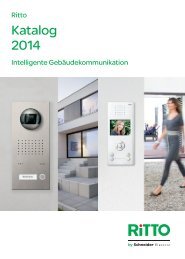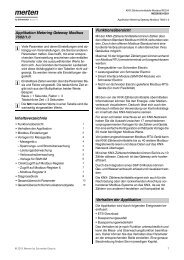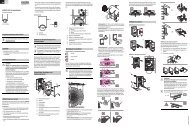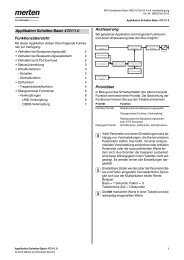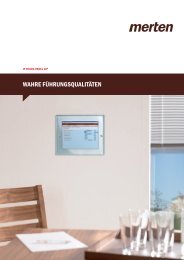ARGUS 220 Zubehör Für Ihre Sicherheit ARGUS kennen ... - Merten
ARGUS 220 Zubehör Für Ihre Sicherheit ARGUS kennen ... - Merten
ARGUS 220 Zubehör Für Ihre Sicherheit ARGUS kennen ... - Merten
Sie wollen auch ein ePaper? Erhöhen Sie die Reichweite Ihrer Titel.
YUMPU macht aus Druck-PDFs automatisch weboptimierte ePaper, die Google liebt.
© <strong>Merten</strong> 2009V5654-584-0304/13<br />
de<br />
<strong>ARGUS</strong> <strong>220</strong><br />
Gebrauchsanleitung<br />
Durch den horizontal, vertikal und axial verstellbaren<br />
Sensorkopf können Sie den Erfassungsbereich optimal<br />
an die örtlichen Gegebenheiten anpassen. Zusätzlich<br />
können Sie unerwünschte Zonen oder Störquellen (wie<br />
z. B. Bäume) durch die mitgelieferten Segmente aus<br />
dem Erfassungsbereich ausblenden.<br />
Das Gerät ist mit einem Lichtfühler ausgestattet, dessen<br />
Helligkeitsschwelle Sie von ca. 3 bis 1000 Lux einstellen<br />
können.<br />
Die Bedienelemente des <strong>ARGUS</strong> befinden sich geschützt<br />
unter der Abdeckplatte. Anhand der Pfeilstellung<br />
können Sie die eingestellten Werte an den Reglern ablesen.<br />
1 Abdeckplatte bis zum fühlbaren Anschlag<br />
(ca. 5 mm) hochschieben und abziehen.<br />
Äußere <strong>Sicherheit</strong>szone C: Erfassungswinkel <strong>220</strong>°<br />
bei einem Erfassungsbereich von ca. 16 m x 28 m.<br />
E<br />
Wenn Sie mehrere Bewegungsmelder anbringen, dann<br />
montieren Sie sie so, dass sich die Erfassungsbereiche<br />
der einzelnen Bewegungsmelder überschneiden.<br />
Anschlussleitung zuführen<br />
1<br />
=<br />
2<br />
E<br />
<strong>ARGUS</strong> im Zusammenspiel mit<br />
Alarmanlagen<br />
D<br />
<strong>ARGUS</strong> montieren<br />
Art.-Nr. 5654..<br />
<strong>Zubehör</strong><br />
|<br />
Der <strong>ARGUS</strong> ist nicht als Komponente einer Alarmanalge<br />
geeignet, da er netzabhängig versorgt<br />
wird und bei Ausfall und Wiederkehr der Netzspannung<br />
den angeschlossenen Alarmmelder<br />
schaltet, unabhängig von einer Bewegung (Fehlalarm).<br />
A<br />
B<br />
C<br />
Montagehöhe D: 2 - 3 m. Wir empfehlen für die optimale<br />
Überwachung eine Höhe von 2,5 m auf festem<br />
und ebenem Untergrund.<br />
Mindestabstand E zu optischen Störquellen: 5m.<br />
Verwenden Sie ggf. die mitgelieferten Segmente zur<br />
Abschattung.<br />
<strong>ARGUS</strong>-Oberteil demontieren<br />
1<br />
=<br />
– Montagewinkel (Art.-Nr. 56529.)<br />
<strong>Für</strong> <strong>Ihre</strong> <strong>Sicherheit</strong><br />
¼ GEFAHR<br />
Gefahr von schweren Sach- und Personenschäden,<br />
z. B. durch Brand oder elektrischen<br />
Schlag, aufgrund einer unsachgemäßen<br />
Elektroinstallation.<br />
Eine sichere Elektroinstallation kann nur gewährleistet<br />
werden, wenn die handelnde Person nachweislich<br />
über Grundkenntnisse auf folgenden<br />
Gebieten verfügt:<br />
• Anschluss an Installationsnetze<br />
• Verbindung mehrerer Elektrogeräte<br />
• Verlegung von Elektroleitungen<br />
• Elektroinstallation im Außenbereich<br />
Über diese Kenntnisse und Erfahrungen verfügen<br />
in der Regel nur ausgebildete Fachkräfte im<br />
Bereich der Elektro-Installationstechnik. Bei<br />
Nichterfüllung dieser Mindestanforderungen<br />
oder Missachtung droht für Sie die persönliche<br />
Haftung bei Sach- und Personenschäden<br />
Bewegungsmelder schalten, sobald sie eine sich bewegende<br />
Wärmequelle wahrnehmen. Dabei kann es sich<br />
um Menschen handeln, aber auch um Bäume, Autos<br />
oder Temperaturdifferenzen in Fenstern. Um Fehlalarme<br />
zu vermeiden, ist der Montageort so zu wählen, dass unerwünscht<br />
auslösende Wärmequellen nicht erfasst werden<br />
können.<br />
Unerwünschte Wärmequellen können sein:<br />
• sich bewegende Bäume, Sträucher usw. die eine andere<br />
Temperatur haben als deren Umgebung.<br />
• Fenster, in denen es durch die Wechselwirkung zwischen<br />
Sonneneinstrahlung und Wolken zu einer<br />
schnellen Temperaturveränderung kommt.<br />
• größere Wärmequellen (z. B. Autos), die durch Fenster<br />
hindurch erfasst werden.<br />
• Insekten, die über die Linse laufen.<br />
• Kleintiere.<br />
• lichtdurchflutete Räume, in denen es aufgrund spiegelnder<br />
Gegenstände (z. B. Böden) zu schnellen Temperaturveränderungen<br />
kommt.<br />
Anschlüsse, Anzeigen und<br />
Bedienelemente<br />
E<br />
A Regler für Empfindlichkeit<br />
B Regler für Schaltdauer<br />
C Regler für Helligkeitsschwelle<br />
D Funktionsanzeige, leuchtet bei jeder erkannten Bewegung<br />
E Helligkeitssensor, darf nicht abgedeckt werden<br />
Montageort auswählen<br />
Erklärung der verwendeten Symbole<br />
Richtig<br />
Nicht optimal<br />
Falsch<br />
D<br />
Bei der Wahl des richtigen Montageortes sollten Sie<br />
zahlreiche Gesichtspunkte beachten, damit der Bewegungsmelder<br />
optimal arbeitet.<br />
OK<br />
Mindestabstand F zwischen Leuchte und Bewegungsmelder:<br />
5m. Sollte der Abstand nicht realisierbar<br />
sein, können Sie die mitgelieferten Segmente<br />
verwenden, um die Lichtquelle aus dem Erfassungsbereich<br />
„auszublenden“.<br />
Montieren Sie den Bewegungsmelder, wenn möglich,<br />
seitlich zur Gehrichtung.<br />
OK<br />
OK<br />
F<br />
2 3<br />
<strong>ARGUS</strong> an die Wand montieren<br />
1<br />
2<br />
<strong>ARGUS</strong> an die Decke montieren<br />
Um den <strong>ARGUS</strong> an die Decke zu montieren, müssen Sie<br />
den Sensorkopf drehen. Wechseln Sie beim Erreichen<br />
der Endanschläge die Drehrichtung.<br />
1 Sensorkopf bis zum Anschlag nach oben drehen.<br />
2 Sensorkopf bis zum Anschlag im Uhrzeigersinn<br />
drehen.<br />
3 Sensorkopf ausrichten.<br />
1 2 3<br />
<strong>ARGUS</strong> <strong>kennen</strong> lernen<br />
Der <strong>ARGUS</strong> <strong>220</strong> (im Folgenden <strong>ARGUS</strong> genannt) ist ein<br />
Bewegungsmelder für den Innen- und Außenbereich.<br />
Der <strong>ARGUS</strong> registriert bewegte Wärmequellen, z. B.<br />
Personen, innerhalb seiner Reichweite und schaltet<br />
beim Er<strong>kennen</strong> einer Bewegung angeschlossenen Verbraucher.<br />
Dies können sein:<br />
– ohmsche Lasten (z. B. 230 V-Glüh- und Halogenlampen)<br />
– induktive Lasten (z. B. Niedervolt-Halogen-Lampen<br />
mit induktivem Trafo)<br />
– kapazitive Lasten (z. B. elektronische Trafos)<br />
Eine <strong>220</strong>°-Flächenüberwachung für größere Hausfronten<br />
und Bereiche des Hauses (max. Reichweite 16 m) ist<br />
kombiniert mit einer 360°-Nahschutzzone mit einem Radius<br />
von ca. 4 m. Die Bedienelemente zur Einstellung<br />
der Helligkeitsschwelle, Schaltdauer und Empfindlichkeit<br />
befinden sich geschützt unter der Abdeckplatte.<br />
Der <strong>ARGUS</strong> kann sowohl an die Wand als auch an die<br />
Decke montiert werden oder mit dem als <strong>Zubehör</strong> erhältlichen<br />
Montagewinkel (Art-Nr. 56529x) an Ecken oder<br />
ortsfesten Rohren.<br />
Die integrierte Funktionsanzeige leuchtet bei einer erkannten<br />
Bewegung auf und vereinfacht Ihnen so das<br />
Ausrichten am Montageort.<br />
H<br />
G<br />
F<br />
A<br />
E<br />
D<br />
A Wandanschlusskasten<br />
B Oberteil<br />
C Abdeckplatte<br />
D Sensorkopf<br />
E Kontaktstifte<br />
F Leitungsdurchführung für Anschlussleitung von unten<br />
G Leitungsdurchführung für Anschlussleitung von hinten<br />
H Klemmblock für Anschlussleitung und Aufnahme<br />
der Kontaktstifte<br />
B<br />
C<br />
|<br />
In der nachfolgenden Abbildung finden Sie die<br />
Reichweiten des <strong>ARGUS</strong> bei durchschnittlichen<br />
Temperaturverhältnisse und einer Montagehöhe<br />
von 2,50 m. Die Reichweite eines Bewegungsmelders<br />
kann bei wechselnden Temperaturen<br />
stark schwanken.<br />
m<br />
2,5<br />
0,8 m<br />
0<br />
4 0 2 4 6 8 10 12 14 16 m<br />
14<br />
B<br />
12<br />
C<br />
A<br />
10<br />
8<br />
6<br />
4<br />
2<br />
0<br />
2<br />
4<br />
6<br />
8<br />
10<br />
12<br />
14<br />
4 2 0 2 4 6 8 10 12 14 16 m<br />
Innere <strong>Sicherheit</strong>szone A: Erfassungswinkel 360°<br />
in einem Radius von ca. 4 m.<br />
Mittlere <strong>Sicherheit</strong>szone B: Erfassungswinkel<br />
<strong>220</strong>° bei einem Erfassungsbereich von ca.<br />
9mx18m.<br />
OK<br />
OK<br />
Damit das Einschalten des angeschlossenen Verbrauchers<br />
durch Umwelteinflüsse vermieden wird, sollten Sie<br />
den <strong>ARGUS</strong> so montieren, dass er vor Regen und direkter<br />
Sonneneinstrahlung geschützt ist. Beispielsweise<br />
kann ein Regentropfen, der über die Linse läuft, den Bewegungsmelder<br />
einschalten.<br />
½ VORSICHT<br />
Bei falscher Montage kann Kondenswasser<br />
das Gerät beschädigen.<br />
Montieren Sie das Gerät bei geneigten Decken<br />
so, dass die Kugel nach unten zeigt, und immer in<br />
einem Neigungswinkel von 15° - 90°. Bei nach<br />
unten zeigender Kugel kann eventuelles Kondenswasser<br />
ablaufen.<br />
|<br />
Bei einem Montagewinkel anders als 15° - 90° ist<br />
die Schutzart IP 55 nicht mehr gegeben.<br />
15° - 90°<br />
V5654-584-03 04/13
<strong>ARGUS</strong> an Ecken und ortsfesten Rohren montieren<br />
Mit dem Montagewinkel (Art.-Nr. 56529x) können Sie<br />
den <strong>ARGUS</strong> an Innen-/Außenecken oder an ortsfesten<br />
Rohren montieren. Die Anschlussleitung können Sie von<br />
hinten durch den Montagewinkel an das Gerät heranführen.<br />
<strong>ARGUS</strong> anschließen<br />
½ VORSICHT<br />
Das Gerät kann beschädigt werden.<br />
Betrieb nur mit sinusförmigen Netzspannungen<br />
möglich. Phasenanschnittdimmer oder Wechselrichter<br />
mit rechteckigem oder trapezförmigen<br />
Spannungsverlauf schädigen das Gerät.<br />
|<br />
|<br />
Sichern Sie den <strong>ARGUS</strong> über einen 16 A-Leitungsschutzschalter<br />
ab.<br />
Beim Schalten von induktiven Lasten wie z. B.<br />
Transformatoren, Relais, Schützen oder Leuchtstofflampen<br />
entstehen Spannungsspitzen, die<br />
zum Wiedereinschalten führen können („Dauerlichteffekt“).<br />
Schalten Sie an der induktiven Last<br />
einen Kondensator parallel, um diese Spannungsspitzen<br />
zu verringern.<br />
• <strong>ARGUS</strong> kombiniert mit Öffner<br />
<strong>ARGUS</strong> ist ständig betriebsbereit. Durch Tastendruck<br />
(kurzzeitige Spannungsunterbrechung 2–3<br />
Sekunden) schalten Sie den <strong>ARGUS</strong> für die eingestellte<br />
Zeit ein. Jede weitere Bewegung verlängert<br />
die Schaltdauer.<br />
L<br />
N<br />
Ö S<br />
N<br />
• <strong>ARGUS</strong> parallel<br />
Mehrere <strong>ARGUS</strong> können eine Lampengruppe<br />
schalten, wenn die maximale Schaltleistung eines<br />
Gerätes nicht überschritten wird. Dazu müssen Sie<br />
die Empfindlichkeit der Geräte reduzieren. Die Bildung<br />
größerer Gerätegruppen mit mehr als vier AR-<br />
GUS ist technisch und funktionell ungünstig.<br />
L<br />
N<br />
L<br />
N<br />
• <strong>ARGUS</strong> kombiniert mit Serienschalter<br />
Je nach Schalterstellung ergibt sich Hand-, Automatikbetrieb<br />
oder “AUS”. In Stellung 1 wird die<br />
Leuchte über den <strong>ARGUS</strong> (Automatik) und in Stellung<br />
2 dauernd (Hand) eingeschaltet.<br />
L<br />
N<br />
L<br />
L<br />
N<br />
N<br />
<strong>ARGUS</strong> in Betrieb nehmen<br />
1 Versorgungsspannung zuschalten.<br />
Der Verbraucher wird für ca. 10 s bzw. die eingestellte<br />
Zeit eingeschaltet. Die Funktionsanzeige leuchtet ca.<br />
10 s lang.<br />
Funktionstest durchführen<br />
Der Helligkeitssensor darf nicht abgedeckt sein.<br />
1 Schaltdauer auf 1 s einstellen (Linksanschlag).<br />
2 Helligkeitsschwelle auf Tagbetrieb stellen (Rechtsanschlag).<br />
3 Empfindlichkeitsregler auf maximal stellen (Rechtsanschlag).<br />
4 Führen Sie Gehproben durch, um die Funktionalität<br />
des <strong>ARGUS</strong> und der angeschlossenen Verbraucher<br />
zu testen.<br />
Die Funktionsanzeige leuchtet bei jeder erkannten Bewegung<br />
auf.<br />
<strong>ARGUS</strong> einstellen<br />
½ VORSICHT<br />
Das Gerät kann beschädigt werden.<br />
Drehen Sie den Sensorkopf nur bis zum Anschlag,<br />
nicht darüber hinaus. Um einen Winkel<br />
„über“ dem Anschlag zu erreichen, wechseln Sie<br />
die Drehrichtung.<br />
1 Den Sensorkopf auf den zu überwachenden Bereich<br />
ausrichten.<br />
Schaltdauer einstellen<br />
Hierüber können Sie einstellen, wie lange der an den<br />
<strong>ARGUS</strong> angeschlossene Verbraucher eingeschaltet<br />
sein soll. Bei Er<strong>kennen</strong> einer Bewegung wird der Verbraucher<br />
eingeschaltet und leuchtet so lange, bis die<br />
eingestellte Zeit verstrichen ist. Jede registrierte Bewegung<br />
startet die Schaltdauer neu.<br />
|<br />
Der <strong>ARGUS</strong> ignoriert nach dem Einschalten des<br />
Verbrauchers den Dämmerungsschalter. Wenn<br />
der Bewegungsmelder nicht mehr ausschaltet,<br />
dann liegt die Ursache wahrscheinlich darin,<br />
dass der <strong>ARGUS</strong> ständig neue Bewegungen erfasst<br />
und so die Schaltdauer immer wieder neu<br />
startet.<br />
Einzelne Bereiche ausblenden<br />
Durch die vier mitgelieferten Segmente können Sie unerwünschte<br />
Zonen und Störquellen aus dem Erfassungsbereich<br />
ausblenden.<br />
|<br />
40 80<br />
20 3<br />
1s<br />
8<br />
min<br />
1,2 sec<br />
40 80<br />
20 3<br />
1s<br />
8<br />
min<br />
8 min 10 sec<br />
A<br />
1 2<br />
Achten Sie darauf, dass der Helligkeitssensor A<br />
nicht verdeckt wird, da sich sonst die Lichtempfindlichkeit<br />
reduziert.<br />
Technische Daten<br />
Nennspannung: AC 230 V ±10%, 50 Hz<br />
Sicherung: Der <strong>ARGUS</strong> ist über einen 16 A-<br />
Leitungsschutzschalter abzusichern.<br />
Max. Schaltstrom: 16 A, AC 230 V, cosϕ = 1<br />
Nennleistung<br />
Glühlampen: AC 230 V, max. 2000 W<br />
Halogenlampen: AC 230 V, max. 1200 W<br />
Leuchtstofflampen:<br />
AC 230 V, max. 1200 W, unkompensiert<br />
Kapazitive Last: 35 µF<br />
Trafolast: max. 600 VA<br />
Eigenverbrauch: < 1 W<br />
Anschlussklemmen: für 2x1,5 mm 2 oder 2x2,5 mm 2<br />
starre Leiter, Abisolierlänge<br />
14 mm<br />
Außendurchmesser<br />
einer Leitung: max. 14,5 mm<br />
Erfassungswinkel: <strong>220</strong>°<br />
Reichweite: max. 16 m<br />
Anzahl der Ebenen: 7<br />
Anzahl der Zonen: 112 mit 448 Schaltsegmenten<br />
Mindestanbauhöhe: 1,7 m<br />
Empfohlene Anbauhöhe:<br />
2,5 m<br />
Empfindlichkeit: stufenlos einstellbar<br />
Lichtfühler: stufenlos von außen einstellbar,<br />
von ca. 3 Lux bis ca. 1000 Lux<br />
Schaltdauer: in 6 Stufen von außen einstellbar,<br />
von ca. 1 s bis ca. 8 min.<br />
Einstellmöglich-keiten<br />
des Sensorkopfes:<br />
Wandmontage:<br />
9° auf, 24° ab, 12° rechts/links,<br />
±12° axial<br />
14 mm<br />
9°<br />
24° 12° 12° 12° 12°<br />
Deckenmontage:<br />
4° auf, 29° ab, 25° rechts/links,<br />
±8,5° axial<br />
Eine Durchverdrahtung zu anderen Verbrauchern ist zulässig<br />
Mögliche Installationsarten<br />
• <strong>ARGUS</strong> ständig am Netz<br />
<strong>ARGUS</strong> überwacht ständig seinen Bereich<br />
1 2<br />
• <strong>ARGUS</strong> parallel mit Treppenlichtautomat<br />
Entweder schaltet der <strong>ARGUS</strong> oder der Treppenlichtautomat<br />
für bestimmte Zeit die Leuchten ein.<br />
L<br />
N<br />
N<br />
On<br />
t<br />
L<br />
N<br />
L<br />
N<br />
4° 29°<br />
25°<br />
25°<br />
8,5° 8,5°<br />
2 Vom Rand her in den Erfassungsbereich gehen, um<br />
zu überprüfen, ob der <strong>ARGUS</strong> den Verbraucher und<br />
die Funktionsanzeige wie gewünscht schaltet.<br />
Empfindlichkeit einstellen<br />
Hierüber können Sie stufenlos einstellen, bis zu welcher<br />
Entfernung der <strong>ARGUS</strong> Bewegungen er<strong>kennen</strong> kann<br />
(bis max. 16 m).<br />
Schutzart:<br />
EG-Richtlinien:<br />
<strong>Merten</strong> GmbH<br />
<strong>Merten</strong> GmbH, Fritz-Kotz-Str. 8, D-51674 Wiehl<br />
www.merten.de<br />
Service Center (Warenrücksendung):<br />
Telefon: +49 2261 702-204<br />
Telefax: +49 2261 702-136<br />
E-Mail: servicecenter@merten.de<br />
Technische Auskünfte/InfoLine:<br />
IP 55 bei einem Neigungswinkelvon<br />
15° bis 90°<br />
Niederspannungs-Richtlinie<br />
2006/95/EG<br />
EMV-Richtlinie 2004/108/EG<br />
L<br />
N<br />
<strong>ARGUS</strong>-Oberteil montieren<br />
1<br />
2 3<br />
Telefon: +49 2261 702-235<br />
Telefax: +49 2261 702-680<br />
E-Mail: infoline.merten@schneider-electric.com<br />
L<br />
N<br />
• <strong>ARGUS</strong> kombiniert mit Wechselschalter<br />
Je nach Schalterstellung ergibt sich Dauerlichtoder<br />
Automatikbetrieb<br />
L<br />
N<br />
Nun können den <strong>ARGUS</strong> in Betrieb nehmen.<br />
Helligkeitsschwelle einstellen<br />
Hier stellen Sie stufenlos ein, ab welcher Umgebungshelligkeit<br />
der <strong>ARGUS</strong> Bewegungen er<strong>kennen</strong> und ein<br />
Schalten auslösen soll.<br />
– Mondsymbol (Nachtbetrieb): <strong>ARGUS</strong> erkennt nur bei<br />
Dunkelheit (bis ca. 3 Lux) Bewegungen.<br />
L<br />
N<br />
– Sonnensymbol (Tag- und Nachtbetrieb): <strong>ARGUS</strong> erkennt<br />
Bewegungen bis ca. 1000 Lux.<br />
3 LUX 1000 LUX<br />
V5654-584-03 04/13
© <strong>Merten</strong> 2009V5654-584-0304/13<br />
en<br />
<strong>ARGUS</strong> <strong>220</strong><br />
Operating instructions<br />
The area of detection can be adapted to the local conditions<br />
due to the horizontally, vertically and axially adjustable<br />
sensor head. You can also block unwanted zones or<br />
sources of interference (e.g. trees) from the area of detection<br />
using the masking segments provided.<br />
The device is fitted with a light sensor whose brightness<br />
threshold can be set between approx. 3 and 1000 lux.<br />
The <strong>ARGUS</strong> operating elements are protected under the<br />
cover plate. The arrow's position on the controllers<br />
shows you the set values.<br />
1 Push up the cover plate until you feel it hit the stop<br />
(approx. 5 mm) and pull it off.<br />
E<br />
If you wish to attach several movement detectors, install<br />
them so that the detection areas of the individual movement<br />
detectors intersect each other.<br />
Feeding in the connecting cable<br />
1<br />
=<br />
Using <strong>ARGUS</strong> with alarm systems<br />
D<br />
E<br />
2<br />
Art. no. 5654..<br />
Accessories<br />
– Mounting bracket (Art. no. 56529.)<br />
For your safety<br />
¼ DANGER<br />
Risk of serious damage to property and personal<br />
injury, e.g. from fire or electric shock,<br />
due to incorrect electrical installation.<br />
Safe electrical installation can only be ensured if<br />
the person in question can prove basic knowledge<br />
in the following areas:<br />
• Connecting to installation networks<br />
• Connecting several electrical devices<br />
|<br />
The <strong>ARGUS</strong> is not suitable for use as a component<br />
of an alarm system since it is supplied from<br />
the mains and will switch the connected alarm<br />
whenever the mains supply fails and recovers, regardless<br />
of whether or not a movement is detected<br />
(false alarm).<br />
Movement detectors switch on as soon as they detect a<br />
moving heat source. This can be a person, but also<br />
trees, cars or differences in temperature in windows. In<br />
order to avoid false alarms, the chosen installation site<br />
should be such that undesired heat sources cannot be<br />
detected.<br />
Undesired sources of heat could include the following:<br />
• moving trees, shrubbery etc. with a temperature that<br />
differs from that of their surroundings.<br />
• windows where the influence of sunlight and clouds<br />
could cause rapid changes in temperature.<br />
• larger heat sources (e.g. cars), that are detected<br />
through windows.<br />
• insects moving across the lens.<br />
• small animals.<br />
• rooms flooded with light where the light is reflected on<br />
objects (e.g. the floor), which can be the cause of rapid<br />
changes in temperature.<br />
E<br />
A Sensitivity controller<br />
B Switching duration controller<br />
C Brightness threshold controller<br />
D Functional display, lights up each time movement is<br />
detected<br />
E Brightness sensor, must not be covered<br />
Selecting the installation site<br />
Explanation of the symbols used<br />
Correct<br />
A<br />
B<br />
C<br />
D<br />
Mounting height D: 2-3 m. For optimum monitoring,<br />
we recommend a height of 2.5 m on a solid and even<br />
base.<br />
Minimum distance E to sources of optical interference:<br />
5 m If necessary, use the segments supplied to<br />
shade the device.<br />
OK<br />
OK<br />
Minimum distance F between luminaire and movement<br />
detector: 5 m. If this distance cannot be<br />
achieved, you can use the segments provided to<br />
"mask" the light source from the area of detection.<br />
If possible, install the movement detector sideways to the<br />
direction of movement.<br />
F<br />
<strong>ARGUS</strong> installation<br />
Dismantlement of the top section of the <strong>ARGUS</strong><br />
1<br />
2 3<br />
Installing the <strong>ARGUS</strong> to the wall<br />
1<br />
=<br />
Installing the <strong>ARGUS</strong> on the ceiling<br />
In order to install the <strong>ARGUS</strong> on the ceiling, you must rotate<br />
the sensor head. Change the direction of rotation<br />
once you have reached the end stops.<br />
1 Turn the sensor head upwards as far as it will go.<br />
2 Turn the sensor head clockwise as far as it will go.<br />
3 Align the sensor head.<br />
• Laying electric cables<br />
• Outdoor electrical installation<br />
These skills and experience are normally only<br />
possessed by skilled professionals who are<br />
trained in the field of electrical installation technology.<br />
If these minimum requirements are not met<br />
or are disregarded in any way, you will be solely liable<br />
for any damage to property or personal injury.<br />
<strong>ARGUS</strong> introduction<br />
The <strong>ARGUS</strong> <strong>220</strong> (referred to below as the <strong>ARGUS</strong>) is a<br />
movement detector for indoor and outdoor installation.<br />
The <strong>ARGUS</strong> registers moving sources of heat within its<br />
range, e.g. people, and switches the loads connected<br />
whenever it detects a movement. This could include:<br />
– ohmic loads (e.g. 230 V incandescent and halogen<br />
lamps)<br />
– inductive loads (e.g. low-voltage halogen lamps<br />
with inductive transformer)<br />
– capacitive loads (e.g. electronic transformers)<br />
Surface monitoring of <strong>220</strong>° for larger house fronts and areas<br />
of the house (max. range of 16 m) is combined with<br />
a 360° short-range zone with a radius of approx. 4 m.<br />
The operating elements for setting the brightness threshold,<br />
switching duration and sensitivity are located under<br />
the cover plate for protection.<br />
Connections, displays and operating<br />
elements<br />
H<br />
G<br />
F<br />
A<br />
E<br />
D<br />
A Wall connection box<br />
B Top section<br />
C Cover plate<br />
D Sensor head<br />
E Contact pins<br />
F Cable routing for connecting cable from underneath<br />
G Cable routing for connecting cable from behind<br />
H Terminal block for the connecting cable and for locating<br />
the contact pins<br />
B<br />
C<br />
When selecting a suitable installation site, you should<br />
take a number of factors into account so that the movement<br />
detector operates optimally.<br />
|<br />
2,5<br />
12<br />
10<br />
Not optimal<br />
Incorrect<br />
The following figure shows the ranges of the AR-<br />
GUS at average temperature conditions and a<br />
mounting height of 2.5 m. The range of a movement<br />
detector can vary greatly depending on the<br />
temperature.<br />
0<br />
4<br />
14<br />
8<br />
6<br />
4<br />
2<br />
0<br />
2<br />
4<br />
6<br />
m<br />
A<br />
0 2 4 6 8 10 12 14 16 m<br />
B<br />
C<br />
0,8 m<br />
OK<br />
OK<br />
OK<br />
To avoid the connected load being switched on due to<br />
environmental influences, the <strong>ARGUS</strong> should be installed<br />
so that it is protected against rain and direct sunlight.<br />
A raindrop running over the lens, for example, can<br />
activate the movement detector.<br />
2<br />
½ CAUTION<br />
If not installed correctly, the device can be<br />
damaged by condensation.<br />
In the case of sloping ceilings, install the device<br />
so that spherical head is pointing down and always<br />
at an angle of 15° - 90°. When the spherical<br />
head points downwards, any water from condensation<br />
could run down the device.<br />
|<br />
Type of protection IP 55 cannot be guaranteed if<br />
the mounting bracket is not 15° - 90°.<br />
15° - 90°<br />
1 2 3<br />
The <strong>ARGUS</strong> can be mounted on the wall or ceiling and<br />
also on to corners or fixed pipes with the mounting<br />
bracket (art. no. 5652x) which is available as an accessory.<br />
8<br />
10<br />
12<br />
14<br />
4 2 0 2 4 6 8 10 12 14 16 m<br />
The integrated functional display lights up when movement<br />
is detected and thus simplifies the alignment of the<br />
device at the installation site.<br />
Inner security zone A: Angle of detection 360° over<br />
a radius of approx. 4 m.<br />
Middle security zone B: Angle of detection <strong>220</strong>°<br />
with an area of detection of approx. 9 m x 18 m.<br />
Outer security zone C: Angle of detection <strong>220</strong>° with<br />
an area of detection of approx. 16 m x 28 m.<br />
V5654-584-03 04/13
Installing the <strong>ARGUS</strong> on corners and fixed pipes<br />
You can attach the <strong>ARGUS</strong> to inner/outer corners or fixed<br />
pipes using the mounting bracket (art. no. 56529x). You<br />
can feed the connecting cable to the device from behind<br />
through the mounting bracket.<br />
• <strong>ARGUS</strong> combined with break contact<br />
The <strong>ARGUS</strong> is always ready for operation. By<br />
pressing the push-button (the power is briefly disconnected<br />
for 2–3 seconds), the <strong>ARGUS</strong> is<br />
switched on for the set period. Every further movement<br />
increases the switching duration.<br />
L<br />
N<br />
Putting <strong>ARGUS</strong> into operation<br />
1 Connect the supply voltage.<br />
The load is switched on for approx. 10 s or for the set period.<br />
The functional display lights up for approx. 10 s.<br />
Conducting a functional test<br />
The brightness sensor must not be covered up.<br />
Setting the switching duration<br />
Here you can set how long the loads connected to AR-<br />
GUS are switched on for. When a movement is detected,<br />
the load is switched on and stays switched on until the<br />
set period has elapsed. Every further movement restarts<br />
the switching duration.<br />
40 80<br />
20 3<br />
40 80<br />
20 3<br />
Technical data<br />
Nominal voltage:<br />
Fuse:<br />
AC 230 V ±10%, 50 Hz<br />
Protect the <strong>ARGUS</strong> using a 16 A<br />
circuit breaker.<br />
Max. switching current:<br />
16 A, AC 230 V, cosϕ = 1<br />
Nominal output<br />
Connecting the <strong>ARGUS</strong><br />
½ CAUTION<br />
The device can become damaged.<br />
Operation only possible with sinusoidal mains<br />
voltages. Phase control dimmers or inverters with<br />
square-wave or trapezoidal voltage curves will<br />
damage the device.<br />
Protect <strong>ARGUS</strong> using a 16 A circuit breaker.<br />
|<br />
|<br />
When switching inductive loads such as transformers,<br />
relays, contactors or fluorescent lamps,<br />
spikes occur which could lead to the load being<br />
switched on again ("maintained light effect").<br />
Connect a capacitor in parallel to the inductive<br />
load to reduce these spikes.<br />
14 mm<br />
Ö S<br />
N<br />
• <strong>ARGUS</strong> connected in parallel<br />
Several <strong>ARGUS</strong> devices working together can<br />
switch a lamp group when the maximum switching<br />
capacity of one device is not exceeded. To do this,<br />
you must reduce the sensitivity of the devices. For<br />
technical and functional reasons, we do not advise<br />
using more than four <strong>ARGUS</strong> devices in one group.<br />
L<br />
N<br />
L<br />
N<br />
• <strong>ARGUS</strong> combined with two-circuit switch<br />
Depending on the switch position, either manual,<br />
automatic mode or "OFF" results. In position 1, the<br />
luminaire is switched on by <strong>ARGUS</strong> (automatic) and<br />
in position 2, it is switched on permanently (manual).<br />
L<br />
N<br />
L<br />
L<br />
N<br />
N<br />
1 Set the switching duration to 1 second (left stop).<br />
2 Set the brightness threshold to daytime operation<br />
(right stop).<br />
3 Set the sensitivity controller to maximum (right<br />
stop).<br />
4 Test the functionality of <strong>ARGUS</strong> and the loads connected<br />
to it by walking to and fro in the detection area.<br />
The functional display lights up each time movement is<br />
detected.<br />
Setting <strong>ARGUS</strong><br />
½ CAUTION<br />
The device could become damaged.<br />
The sensor head should only be rotated until it<br />
reaches the stop and no further. To achieve an<br />
angle "above" the stop, change the direction of<br />
rotation.<br />
1 Align the sensor head in the direction of the area<br />
that is to be monitored.<br />
9°<br />
24° 12° 12° 12° 12°<br />
|<br />
The <strong>ARGUS</strong> ignores the light-sensitive switch<br />
once the load has been switched on. If the movement<br />
detector does not switch the load off again,<br />
the reason probably is that the <strong>ARGUS</strong> constantly<br />
detects further movements and thus keeps restarting<br />
the switching duration.<br />
Blocking out individual areas<br />
Using the four segments supplied, you can block out unwanted<br />
zones and sources of interference from the area<br />
of detection.<br />
|<br />
1s<br />
8<br />
min<br />
1,2 sec<br />
1s<br />
8<br />
min<br />
8 min 10 sec<br />
A<br />
1 2<br />
Ensure that the brightness sensor A is not covered,<br />
as the sensitivity to light is otherwise reduced.<br />
Incandescent<br />
lamps:<br />
Halogen lamps:<br />
Fluorescent<br />
lamps:<br />
AC 230 V, max. 2000 W<br />
AC 230 V, max. 1200 W<br />
Capacitive load: 35 µF<br />
Transformer load: max. 600 VA<br />
Power consumption: < 1 W<br />
Connecting terminals:<br />
AC 230 V, max. 1200 W, uncompensated<br />
for 2x1.5 mm 2 or 2x2.5 mm 2 rigid<br />
conductor, stripped length 14 mm<br />
External diameter of<br />
one cable: max. 14.5 mm<br />
Angle of detection: <strong>220</strong>°<br />
Range:<br />
max. 16 m<br />
Number of levels: 7<br />
Number of zones: 112 with 448 switching segments<br />
Minimum mounting<br />
height:<br />
1.7 m<br />
Recommended<br />
mounting height: 2.5 m<br />
Sensitivity: infinitely adjustable<br />
Light sensor: infinitely adjustable externally,<br />
from approx. 3 lux to approx.<br />
1000 lux<br />
Switching duration: externally adjustable in 6 levels of<br />
approx. 1 sec. to approx. 8 min.<br />
Possible settings for<br />
sensor head:<br />
Wall mounting:<br />
9° up, 24° down, 12° left/right,<br />
± 12° axial<br />
Ceiling mounting: 4° up, 29° down, 25° left/right,<br />
± 8.5° axial<br />
"Through-wiring" to other loads is permitted.<br />
1 2<br />
• <strong>ARGUS</strong> parallel to staircase timer<br />
Either <strong>ARGUS</strong> or the staircase timer switches the<br />
lights on for a certain period.<br />
L<br />
N<br />
L<br />
N<br />
4° 29°<br />
25°<br />
25°<br />
8,5° 8,5°<br />
2 From its edge step into the area of detection to see<br />
whether the <strong>ARGUS</strong> switches the load and the functional<br />
display as required.<br />
Type of protection: IP 55 at an angle of inclination from<br />
15° to 90°<br />
EC directives: Low-voltage guideline 2006/95/<br />
EG<br />
EMC directive 2004/108/EG<br />
<strong>Merten</strong> GmbH<br />
Installation options<br />
Setting the sensitivity<br />
<strong>Merten</strong> GmbH, Fritz-Kotz-Str. 8, D-51674 Wiehl<br />
• <strong>ARGUS</strong> permanently connected to the mains<br />
<strong>ARGUS</strong> constantly monitors its area<br />
L<br />
N<br />
N<br />
On<br />
t<br />
L<br />
N<br />
Here you can infinitely set the distance up to which AR-<br />
GUS detects movements (any distance up to max. 16<br />
m).<br />
www.merten.com<br />
Service Center:<br />
Phone: +49 2261 702-204<br />
Fax: +49 2261 702-136<br />
E-Mail: servicecenter@merten.de<br />
L<br />
N<br />
Installation of the top section of the <strong>ARGUS</strong><br />
1<br />
2 3<br />
Technical support/InfoLine:<br />
Phone: +49 2261 702-235<br />
Fax: +49 2261 702-680<br />
E-Mail: infoline.merten@schneider-electric.com<br />
• <strong>ARGUS</strong> combined with two-way switch<br />
Depending on the switch position, either maintained<br />
light or automatic mode<br />
L<br />
N<br />
L<br />
N<br />
The <strong>ARGUS</strong> can now be put into operation.<br />
Setting the brightness threshold<br />
Here you can infinitely set the ambient brightness level at<br />
which the <strong>ARGUS</strong> detects movements and triggers a<br />
switching procedure.<br />
– Moon symbol (night operation): The <strong>ARGUS</strong> will only<br />
detect movements during the hours of darkness (approx.<br />
3 lux).<br />
– Sun symbol (day and night operation): The <strong>ARGUS</strong><br />
detects movements up to approx. 1000 lux.<br />
3 LUX 1000 LUX<br />
V5654-584-03 04/13


